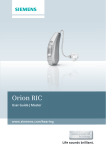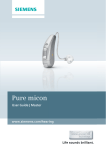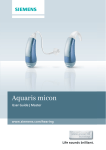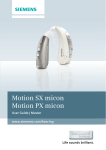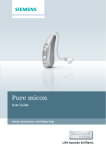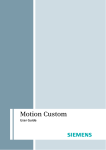Download Siemens BestSound Ace micon User guide
Transcript
Ace micon User Guide | Master www.siemens.com/hearing Life sounds brilliant. Content Welcome 4 Your hearing instruments Getting to know your hearing instruments Components and names Controls Settings Battery size and ear pieces Service information 5 5 6 7 9 10 11 Batteries Replacing non-rechargeable batteries 12 12 Daily use Turning on and off Inserting Removing Adjusting the volume Changing the hearing program 14 14 15 17 18 18 On the phone Telephone program 19 19 Maintenance and care Cleaning Drying Storage Exchanging ear pieces 20 20 21 21 21 2 Content Troubleshooting 23 Important information Intended use Explanation of symbols Transport and storage conditions Disposal information Conformance information 24 24 24 24 25 25 Important safety information Personal safety Product safety Tinnitus noiser 26 26 27 29 Country-specific information 33 Content 3 Welcome You have chosen a Siemens hearing instrument, a reliable partner to accompany you through everyday life. Like everything new, it will take you a little while to become familiar with it. This document, along with support from your Hearing Care Professional, will help you. You will quickly come to appreciate the advantages and greater quality of life your hearing instrument offers. CAUTION Read this user guide thoroughly and completely and follow the safety information in this document to avoid damage or injury. To benefit most from your hearing instrument, wear it daily and all day long. Especially after longer periods of living with hearing loss, a dedicated hearing training is recommended - with a Hearing Care Professional or at home. 4 Welcome Your hearing instruments Getting to know your hearing instruments It is recommended to familiarize yourself with your new hearing instruments. With the instruments in your hand try using the controls and note their location on the instrument. This will make it easier for you to feel and press the controls while wearing the hearing instruments. NOTICE uDo not pull the receiver connection as this could damage your hearing instruments. Your hearing instruments 5 Components and names ૠ ➊ Ear piece ➎ Push button (optional) ➋ Receiver ➏ Battery compartment ➌ Receiver cable ➐ Side indicator (red = right ear, blue = left ear) ➍ Microphone openings ➑ Receiver connection 6 Your hearing instruments Controls With the controls you can, for example, switch hearing programs. Your hearing instruments either have a push button or no control. The Hearing Care Professional has assigned your desired functions to the push button. Ask your Hearing Care Professional to mark your controls and their functions on the following pages. Control Left Right Push button No control Your hearing instruments 7 Push button Function Left Right Program change Standby/turn on press briefly, 8 press 2 seconds Your hearing instruments Settings Ask your Hearing Care Professional to mark your individual settings on the following pages. Hearing programs 1 2 3 4 5 6 Read more in section "Changing the hearing program". Features Power-on delay enables whistle-free insertion of hearing instruments. Read more in section "Turning on and off". Your hearing instruments 9 Battery size and ear pieces Batteries Non-rechargeable (size 10) Exchangeable ear pieces Click Dome single (open or closed) Click Dome semi-open Click Dome double Custom shell Click Mold 10 Your hearing instruments Size Service information Serial numbers Left: Right: Service dates 1: 2: 3: 4: 5: 6: Your Hearing Care Professional Date of purchase: Your hearing instruments 11 Batteries When the battery is low the sound becomes weaker or you will hear an alert signal. It depends on the battery type how long you have until you have to replace the battery. Replacing non-rechargeable batteries Remove empty batteries immediately and dispose of according to local regulations. Remember to have your replacement batteries with you at all times. Removing: uOpen the battery compartment. The battery falls out when the compartment is completely open. uIf the battery does not fall out, lightly tap the instrument or use the magnet stick. The magnet stick is available as an accessory. 12 Batteries Inserting: uRemove the protective film from the new battery. uInsert the battery with the "+" symbol facing up (refer to the picture). uCarefully close the battery compartment. If you feel resistance, the battery is not inserted correctly. Do not attempt to close the battery compartment by force. It can be damaged. Batteries 13 Daily use Turning on and off You have several options to turn your hearing instruments on or off. Via battery compartment: uTurning on: Close the battery compartment. The default volume and hearing program are set. uTurning off: Open the battery compartment. Via push button: uTurning on or off: Press the push button for 2 seconds. Refer to section "Controls" for your personal settings. After turning on, the previously used volume and hearing program are set. ■ When wearing the hearing instruments, an optional signal can indicate when an instrument is turned on or off. ■ Remove the batteries if the hearing instruments are not used for several days. When the power-on delay is activated, the hearing instruments turn on after a delay of several seconds. During this time you can insert the hearing instruments without experiencing unpleasant whistling. The "power-on delay" can be activated by your Hearing Care Professional. 14 Daily use Inserting Your hearing instruments have been fine-tuned for your right and left ear. Colored markers indicate the side: ■ red marker = right ear ■ blue marker = left ear To insert the hearing instrument: uHold the receiver cable at the bend. uCarefully push the ear piece in the ear canal ➊. uTwist it slightly until it sits well. Open and close your mouth to avoid accumulation of air in the ear canal. uLift the hearing instrument and slide it over the top of your ear ➋. CAUTION Risk of injury! uInsert the ear piece carefully and not too deeply into the ear. Daily use 15 ■ Insert the right hearing instrument with the right hand and the left hearing instrument with the left hand. ■ If you have problems inserting the ear piece, use the other hand to gently pull your earlobe downwards. This opens the ear canal and eases insertion of the ear piece. The optional concha lock helps to securely retain the ear piece in your ear. To position the concha lock: uBend the concha lock and position it carefully into the bowl of your ear (refer to the picture). 16 Daily use Removing uLift the hearing instrument and slide it over the top of your ear ➊. uIf your hearing instrument is equipped with a custom shell or a Click Mold, remove it by pulling the small removal cord toward the back of your head. uFor all other ear pieces: Grip the receiver in the ear canal with two fingers and pull it carefully out ➋. CAUTION Risk of injury! uIn very rare cases the ear piece could remain in your ear when removing the hearing instrument. If this happens, have the ear piece removed by a medical professional. Clean and dry your hearing instruments after usage. Read more in section "Maintenance and care". Daily use 17 Adjusting the volume Your hearing instruments automatically adjust the volume to the listening situation. Changing the hearing program Hearing programs change the characteristics of the sound coming through the hearing instrument. They help you to select the optimal setup for every listening situation. An optional signal can indicate the change of the hearing program. uTo change the hearing program, press the push button briefly. Refer to section "Controls" and to section "Settings" for your personal settings of the push button and for a list of your hearing programs. 18 Daily use On the phone When you are on the phone, hold the telephone receiver slightly above your ear. The hearing instrument and telephone receiver have to be aligned. Turn the receiver slightly so that the ear is not completely covered. Telephone program You may prefer a certain volume when using the phone. Ask your Hearing Care Professional to configure a telephone program. uSwitch to the telephone program whenever you are on the phone. Whether a telephone program is configured for your hearing instrument is listed in section "Settings". On the phone 19 Maintenance and care Siemens hearing instruments are so robust that they will function reliably for years. It is, however, important that you take care of your instruments and observe a few basic rules, which will soon become habit. Cleaning For hygiene reasons and to maintain functionality, clean your hearing instruments daily. NOTICE uDo not put your hearing instruments in water. uClean your hearing instruments with a soft, dry tissue. uWhen using a Click Dome, clean it by squeezing the tip of the dome. uAsk your Hearing Care Professional for recommended cleaning products, special care sets and further information on how to keep your hearing instruments in good condition. uFor a more thorough professional cleaning, take your instruments to your Hearing Care Professional. 20 Maintenance and care Drying uDry your hearing instruments overnight. uAsk your Hearing Care Professional for recommended drying products. Storage uDuring longer periods of non-use, store your hearing instruments with open battery compartment (and batteries removed) in a drying system in order to prevent the penetration of moisture. Exchanging ear pieces You may want to exchange the ear pieces from time to time. The procedure for exchanging ear pieces depends on the type of ear piece. In section "Settings", your Hearing Care Professional has marked your type of ear piece. Maintenance and care 21 Exchanging Click Domes If you have problems removing the old Click Dome, use the packaging of the Click Domes or the removal tool: The removal tool is available as an accessory. To exchange Click Domes: uFollow the instructions on the packing of the Click Domes or the instructions delivered with the removal tool. uTake particular care that the new Click Dome clicks noticeably in place. Exchanging Click Molds or custom shells uAsk your Hearing Care Professional. 22 Maintenance and care Troubleshooting Problem and possible solutions Sound is weak. ■ Replace the empty battery. ■ Clean or exchange the ear piece. Hearing instrument emits whistling sounds. ■ Reinsert the ear piece until it fits securely. ■ Clean or exchange the ear piece. Sound is distorted. ■ Replace the empty battery. ■ Clean or exchange the ear piece. Hearing instrument emits signal tones. ■ Replace the empty battery. Hearing instrument does not work. ■ Turn the hearing instrument on. ■ Gently close the battery compartment completely. ■ Replace the empty battery. ■ Make sure the battery is inserted correctly. ■ Power-on delay is active. Wait several seconds and check again. Consult your Hearing Care Professional if you encounter further problems. Troubleshooting 23 Important information Intended use Hearing instruments are intended to improve the hearing of hearing impaired persons. Diagnosis and prescription of a hearing instrument must be performed by hearing health specialists, e.g. acousticians, audiologists or ENT doctors. Use the hearing instruments and accessories only as described in this user guide. Explanation of symbols Points out a situation that could lead to serious, moderate, or minor injuries. Indicates possible property damage. Advice and tips on how to handle your device better. Transport and storage conditions During extended periods of transport and storage, please observe the following conditions: Storage Transport Temperature 10 to 40 °C -20 to 60 °C Relative humidity 10 to 80 % 5 to 90 % Air pressure 700 to 1050 hPa 200 to 1200 hPa For other parts, such as batteries, other conditions may apply. 24 Important information Disposal information Within the European Union, the marked equipment is covered by "Directive 2002/96/EC of the European Parliament and of the Council of 27 January 2003 on waste electrical and electronic equipment." Amended by "Directive 2003/108/EC" (WEEE). NOTICE uRecycle hearing instruments, accessories and packaging according to national regulations. NOTICE uTo avoid environmental pollution, do not throw batteries into household trash. uRecycle or dispose of batteries according to national regulations or return them to your Hearing Care Professional. Conformance information With the CE marking Siemens confirms compliance with the European Directive 93/42/EEC concerning medical devices. Important information 25 Important safety information Personal safety CAUTION Risk of injury! uAlways wear the receiver cable with an ear piece. uMake sure that the ear piece is completely attached. WARNING Risk of impairing the residual hearing of the user. uUse only hearing instruments that have been fitted especially for your needs. WARNING Risk of injury! uDo not use obviously damaged devices and return them to point of sale. WARNING Risk of explosion! uDo not use your hearing instruments in explosive atmospheres (e. g. in mining areas). 26 Important safety information WARNING Choking hazard! Your hearing instruments contain small parts which can be swallowed. uKeep hearing instruments, batteries and accessories out of reach of children and mentally disabled persons. uIf parts have been swallowed consult a physician or hospital immediately. Siemens offers special hearing instruments for the fitting of infants and small children. uAsk your Hearing Care Professional for further information. Product safety NOTICE Leaking batteries damage the hearing instruments. uTurn the hearing instruments off when not in use to preserve the battery. uRemove batteries when the instruments are not in use for a prolonged period of time. Important safety information 27 NOTICE uProtect your hearing instruments from extreme heat. Do not expose them to direct sunlight. NOTICE uDo not dry your hearing instruments in the microwave oven. NOTICE Different types of strong radiation, e. g. during X-ray or MRI head examinations, may damage hearing instruments. uDo not wear the hearing instruments during these or similar procedures. Weaker radiation, e. g. from radio equipment or airport security, does not damage the hearing instruments. NOTICE uProtect your hearing instruments from high humidity. Do not wear them in the shower or when you apply make-up, perfume, aftershave, hairspray or suntan lotion. 28 Important safety information Tinnitus noiser Your hearing instrument may be equipped with a tinnitus noiser. The use of the tinnitus noiser should be only on the advice and in consultation with your Hearing Care Professional. WARNING Risk of further impairment to the user’s hearing health. There are some potential concerns associated with the use of any sound generating tinnitus therapy device. Discontinue use and seek medical evaluation if any of the following conditions occur: uchronic skin irritation on, near, or around the site of device placement. uunusual side effects (e.g. dizziness, nausea, headaches, heart palpitations). uperceived decrease in auditory function (e.g. decreased loudness, speech not as clear). Important safety information 29 WARNING Risk of further impairment to the user’s hearing health. The volume of the tinnitus noiser can be set to a level which could lead to permanent hearing damage when used for a prolonged period of time. uThe tinnitus noiser should never be used at uncomfortable levels. 30 Important safety information For Hearing Care Professionals: The target population is primarily the adult population over 21 years of age. The patient may have some control of the level or volume of the signal and the patient should discuss this adjustment as well as his or her comfort level and sound of the signal with their Hearing Care Professional. WARNING Risk of further impairment to the user’s hearing health. The volume of the tinnitus noiser can be set to a level which could lead to permanent hearing damage when used for a prolonged period of time. uShould the tinnitus noiser be set to such a level in the hearing instrument, advise the user of the maximum amount of time per day he or she should use the tinnitus noiser. For example, occupational safety guidelines restrict continuous noise exposure of 80 dBA SPL to 8 hours per day. uThe tinnitus noiser should never be used at uncomfortable levels. Important safety information 31 WARNING Risk of further impairment to the user’s hearing health. A Hearing Care Professional should advise a prospective tinnitus noiser user to consult promptly with a licensed physician (preferably an ear specialist) before using the tinnitus noiser if the Hearing Care Professional determines through inquiry, actual observation, or review or any other available information concerning the prospective user that the prospective user has any of the following conditions: uVisible congenital or traumatic deformity of the ear. uHistory of active drainage from the ear within the previous 90 days. uHistory of sudden or rapidly progressive hearing loss within the previous 90 days. uAcute or chronic dizziness. uUnilateral hearing loss of sudden or recent onset within the previous 90 days. 32 Important safety information Country-specific information Country-specific informatio 33 34 Siemens Audiologische Technik GmbH Gebbertstrasse 125 91058 Erlangen Germany Phone +49 9131 308 0 Document No. A91SAT-01966-99T##-#### ## Order/Item No. ### ### ## | Master Rev04, 10.2013 · MS Printed in Germany | © Siemens AG, ##.2013 www.siemens.com /hearing




































